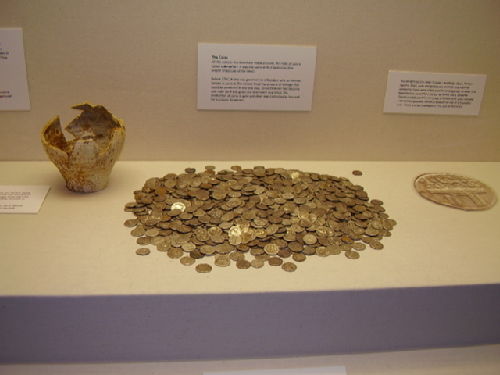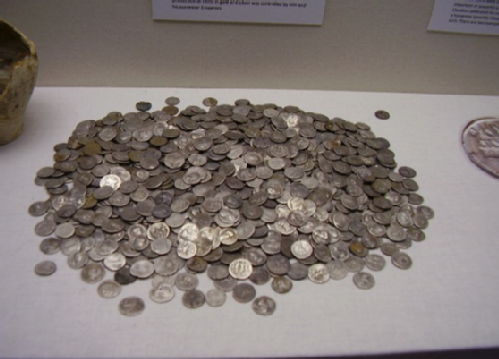All 2 entries tagged Gaius Caesar
No other Warwick Blogs use the tag Gaius Caesar on entries | View entries tagged Gaius Caesar at Technorati | There are no images tagged Gaius Caesar on this blog
July 15, 2014
Augustus and Communicating the Succession
 |
|
Augustus and Agrippa seated on a platform |
As the first emperor or princeps of Rome, Augustus' power was based solely on the positions he held and his proven achievements. There was no established mechanism by which a successor could come to power; the idea of a hereditary monarchy did not exist. Therefore the question of who or what would follow Augustus was a problem indeed, particularly since Augustus himself had no living male heir when he became seriously ill in 23 BC. After the death of her first husband, Augustus married his daughter Julia to his chief general and advisor, Agrippa. The sons of this union, Gaius and Lucius Caesar, were then adopted by Augustus in 17 BC. In order to designate them as successors these brothers were granted a series of honours and positions in spite of their young ages.
 |
|
Aureus with Augustus and Agrippa |
The entire process of appointing a successor a delicate one, and one of our first indications of an official statement of dynastic ideology can be found in a series of coins issued at Rome in 13 BC. This was the year the tribunician power of Augustus and Agrippa was renewed, and Agrippa is shown on the coinage as Augustus' colleague (just as he is later named as a colleague in the Res Gestae Divi Augusti 8.2). Coins show Augustus and Agrippa side-by-side: on the coin above, the portrait of Augustus graces the obverse, while Augustus and Agrippa are seated in togas on the reverse (RIC 12 407). Other issues of this year display the head of Augustus on one side, and the head of Agrippa on the other. On the silver denarius issue of this type, both Augustus and Agrippa are bare-headed, while on the gold aureus issue shown here Augustus wears an oak-crown (an honour granted him by the Senate) and Agrippa a combined mural and rostral crown, which combined the walls of a city and the prow of a ship (RIC 12 409). Silver denarii were also struck showing Julia and her two sons: the obverse carries the portrait of Augustus accompanied by a lituus, and the reverse displays the bust of Julia with a wreath above it, flanked by the busts of her sons (RIC 12 404-5).
 |
|
Denarius showing Julia between Gaius and Lucius |
Alas, the following year Agrippa died, and Gaius and Lucius would both also die before Augustus. It was this series of unfortunate deaths that meant that Tiberius would marry Julia and as Augustus' adopted son, become the successor of his power and offices.
(Images are © The Trustees of the British Museum).
Good images of all of Augustus' coinage can also now be found on the Online Coins of the Roman Empire site.
May 01, 2014
Coin of the Month: A Denarius of Augustus, Presenting a Dynasty
 |
| Denarius of Augustus |
This denarius of Augustus dates from 2-4 BC. The obverse features a laureate head of Augustus with the legend ‘CAESAR AVGVSTVS DIVI F PATER PATER PATRIAE’. The reverse depicts his two grandsons Gaius and Lucius stood facing each other, hands resting on a shield and spear, with a simpulum and lituus above. The legend around the edge reads ‘AVGVSTI F COS DESIG PRINC IVVENT’ and ‘C L CAESARES’ is written horizontally underneath the figures.
The coin is a useful example of the control that Augustus exercised over his personal image. The bust appears as that of a young man, however the emperor would have been in his 60s at this point. It is also illustrative of the problem of succession that faced an ageing Augustus. Having no sons of his own, the emperor had adopted his two grandsons and this coin is a clear message that they are the heirs to his title and powers. The beginning of their public careers is alluded to by the presentation of the title of “Leaders of the Youth”, as well as the appearance of both military and priestly images around them. Gaius’ and Lucius’ positions within the family are also emphasised by the fact that the two are explicitly called the sons of Augustus. Also, the prominent way in which ‘Caesares’ is placed upon the coin has clearly dynastic overtones, especially given that it was the name that Augustus himself took following his own “adoption” by Julius Caesar, which launched his political career. This theme is further continued on the obverse, where Augustus presents the title ‘Divi Filius’ (“Son of a God”) alongside that of ‘Pater Patriae’ (“Father of the Country”). By presenting himself as both son and father, Augustus is drawing the parallel to his own adoption as well as that of his grandsons and it is made clear that an imperial dynasty, with the successive handing down of powers, has been founded.
This particular denarius is contained within the South-Warwickshire Hoard of Roman denarii, which was discovered in 2008 by a local metal-detectorist. The hoard is comprised of 1153 silver denarii, with dates ranging from 190 BC to AD 64. It is one of the largest coin hoards from the Roman world and is made even more special by the fact that the pot in which the coins were buried has also survived. The South-Warwickshire Hoard was acquired by Warwickshire Museum, catalogued by Stanley Ireland and it is currently on display at the Market Hall Museum in Warwick.
 |
 |
The South Warwickshire Hoard in the Warwickshire Museum
This month's coin was chosen by Abigael Flack, a museum assistant at the Warwickshire museum. Abigael is interested in the presentation and reception of the Roman imperial regime, particularly in literature. Her MA thesis examined this theme in the biographies of Suetonius.
(Images courtesy of Sara Wear and Heritage & Culture Warwickshire.)
 Clare Rowan
Clare Rowan

 Please wait - comments are loading
Please wait - comments are loading

 Loading…
Loading…

